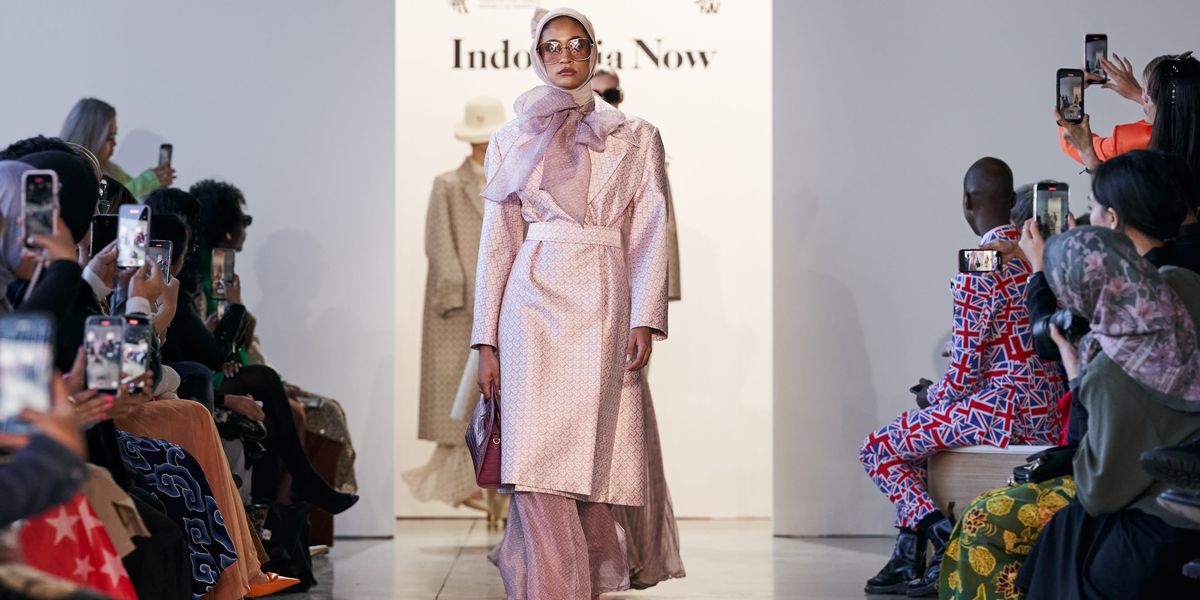Buttonscarves/ New York Fashion Week 2023
Asapracticing Muslim woman, I try to dress as modestly as possible. But growing up, it was clear that being stylish meant revealing a lot of skin — dressing in short shorts, sleeveless tank tops, crop tops and mini skirts, for example. What I saw in magazines and on TV convinced me that dressing modestly was inherently unfashionable.
But finally, status quo disruptors such as Malala Yousafzai — who wore a stunning sequined dress with an attached hijab at the Oscars — are redefining high fashion. Between her modest glam and the Indonesia Now runway show I recently got to attend during New York Fashion Week, I’m beginning to see that there’s plenty of room for modesty and sartorial self-expression. And I hope the rest of America catches on.
Malala Yousafzai attends the 95th Annual Academy Awards on March 12 in Hollywood.
I tend to dress modestly out of my own conviction, but I have always felt stuck in the margin when it came to style. When I moved to New York City four years ago at 17, I became more exposed to the trends of many diverse, non-Western communities, including other Muslim women. This reignited my interest in fashion.
And this past February, I was invited to attend New York Fashion Week’s Indonesia Now show, which was unlike any other runway show I’d ever seen. The models that walked down the runway were beautiful, confident and dressed in innovative ensembles — ones that included hijabs, burqas or niqabs. I was in awe, as this was the first time I had ever truly seen myself in high fashion.
I had the opportunity to chat with the designers of the show, all of whom were Muslim women, and we discussed their journey in the fashion industry as modest designers, their inspirations, the role of their faith in their work, and more. All of these powerhouses had a common philosophy: Make fashion accessible and empowering to Muslim women — and anyone else who doesn’t want to show a lot of skin.
Trisha Chas of Indonesian fashion house Zeta Prive said she finds drive in her quest to create modest clothing options for Muslim women that are luxurious, rather than basic or simple. Many of her designs include intricate and bejeweled outfits, reflective of the multilayered spirit of the women they adorn. Chas’ faith is a big motivator for her; one of her greatest inspirations when starting her business and launching her styles was businessman Abdul Rahman bin Auf, described in the Holy Quran as one of the companions of the Islamic prophet Muhammad, who worked tirelessly to benefit others and with perfection.
Design from fashion house Basunder x Batik Tusmi at the Indonesia Now show.
Linda Anggrea, the head designer and CEO of Buttonscarves, described her brand’s philosophy as one that empowers women to pursue their dreams through beauty and confidence. The ensembles from Buttonscarves lit up the runway, mastering clean lines and a loose, flowy look for those craving an alternative to skintight everything.
Linda Anggrea, the designer and CEO of Buttonscarves, with her pieces backstage.
Istafiana Candarini, Nadya Karina and Afina Candarini, the founders and designers of Kami for HGLModest highlighted the beauty of individuality. This season, their designs were heavily influenced by Tapis Lampung, traditional Indonesian cloth and textiles, to display the strength within women of the past, to empower the future.
Afina Candarini (left), Istafiana Candarini (center) and Nadya Karina (right), the founders and designers behind KAMI.
By making modest fashion more accessible through versatility, Nada Puspita, the founder and designer of her eponymous brand, said she hopes to expand the market of modest fashion with innovative dresses, blazers, skirts and scarves. Modest fashion is the future, she told me, pointing to growth of her company and growing excitement around the movement.
Part of the push forward is navigating the resistance to modest high fashion. Puspita described struggling to make her designs appealing to American consumers at New York Fashion Week, without compromising her pledge of modesty. She told me, however, that her faith is a constant reminder that her work is an expression of gratitude and servitude toward God, and her mission to serve women who want to dress modestly.
Talking to these women and seeing models grace the runway in long sleeves and scarves helped me realize that I could free myself from the idea that high fashion equates to showing a lot of skin.
Those who chose to cover up their bodies — which is an act of self-expression in itself — deserve to wear art just like Bella Hadid or any other Gucci-clad supermodel does. The choice to dress modestly is truly an act of independence and empowerment, as it is the decision to put your faith and comfort above societal trends or expectations.
Fashion is supposed to be an outward reflection of one’s inward inspirations, not a rigid structure dictated by one underlying rule about how much of someone’s body you can see. Feeling confined and pressured by a false narrative is not what’s hot. Feeling like your most authentic self is.
